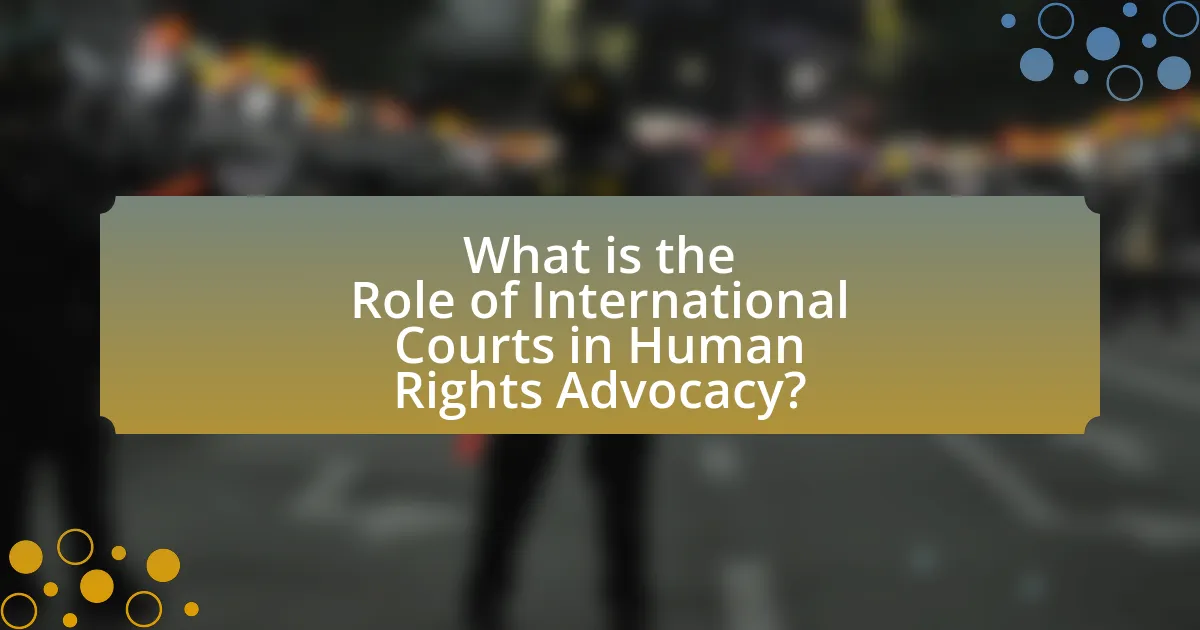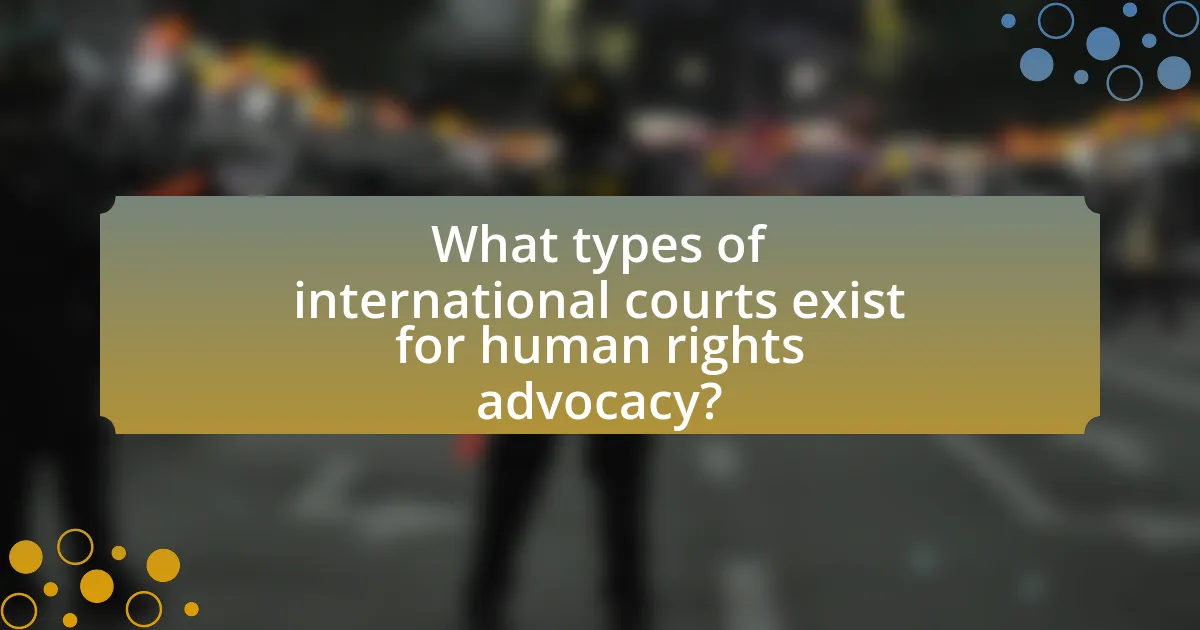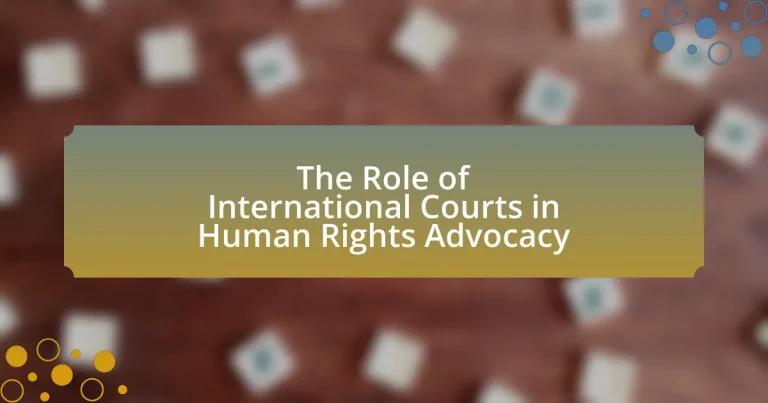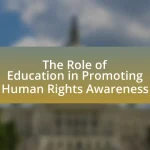International courts play a vital role in human rights advocacy by providing a legal framework for enforcing human rights standards and holding violators accountable. This article examines the functions of various international courts, including the International Criminal Court and regional tribunals like the European Court of Human Rights, in adjudicating human rights cases, establishing legal precedents, and influencing national legal systems. It also discusses the challenges these courts face, such as jurisdictional limitations and political resistance, while highlighting best practices for enhancing their effectiveness in promoting human rights globally. Additionally, the article explores the impact of international court rulings on public policy and the importance of collaboration with NGOs to improve outcomes in human rights advocacy.

What is the Role of International Courts in Human Rights Advocacy?
International courts play a crucial role in human rights advocacy by providing a legal framework for the enforcement of human rights standards and holding violators accountable. These courts, such as the International Criminal Court and regional human rights tribunals, adjudicate cases involving human rights abuses, thereby promoting justice and deterring future violations. For instance, the European Court of Human Rights has issued landmark rulings that have led to significant changes in national laws and practices, reinforcing the protection of individual rights across member states. Additionally, international courts contribute to the development of human rights law by interpreting treaties and establishing legal precedents that guide future cases, thus enhancing the global human rights regime.
How do international courts contribute to the protection of human rights?
International courts contribute to the protection of human rights by adjudicating cases that involve violations of human rights and establishing legal precedents that hold states accountable. For instance, the European Court of Human Rights has ruled on numerous cases that have led to significant changes in national laws and practices, reinforcing the obligation of states to uphold human rights standards as outlined in the European Convention on Human Rights. Additionally, international courts, such as the International Criminal Court, prosecute individuals for crimes against humanity, thereby deterring future violations and promoting justice for victims. These actions collectively enhance the enforcement of human rights norms globally.
What are the key functions of international courts in human rights cases?
International courts play a crucial role in human rights cases by adjudicating disputes, ensuring accountability, and providing remedies for victims. These courts, such as the International Criminal Court and regional human rights tribunals, interpret and apply international human rights law, thereby establishing legal precedents that guide future cases. They also facilitate the enforcement of human rights standards by holding states and individuals accountable for violations, as seen in landmark cases like the European Court of Human Rights’ rulings against member states for failing to uphold the European Convention on Human Rights. Additionally, international courts offer a platform for victims to seek justice, which is essential for redress and deterrence of future violations.
How do international courts enforce human rights standards?
International courts enforce human rights standards primarily through legal rulings and the establishment of binding obligations for states. These courts, such as the International Criminal Court and regional bodies like the European Court of Human Rights, interpret and apply international human rights treaties, ensuring compliance by member states. For instance, the European Court of Human Rights has the authority to issue judgments that require states to amend their laws or practices to align with human rights standards, as seen in cases like the landmark ruling in the case of “Handyside v. United Kingdom,” which reinforced freedom of expression. Additionally, international courts can impose sanctions or recommend measures to ensure accountability, thereby promoting adherence to human rights norms globally.
Why are international courts important for human rights advocacy?
International courts are crucial for human rights advocacy because they provide a legal framework for holding states accountable for human rights violations. These courts, such as the International Criminal Court and regional human rights tribunals, enable individuals and groups to seek justice when domestic legal systems fail. For instance, the European Court of Human Rights has successfully ruled on cases that have led to significant changes in national laws and practices, reinforcing the protection of human rights across member states. By establishing legal precedents and offering a platform for victims, international courts enhance the enforcement of human rights standards globally.
What impact do international courts have on national legal systems?
International courts significantly influence national legal systems by establishing binding precedents and promoting adherence to international human rights standards. These courts, such as the International Criminal Court and the European Court of Human Rights, compel nations to align their domestic laws with international obligations, thereby enhancing the protection of human rights. For instance, the European Court of Human Rights has ruled on numerous cases that require member states to amend their laws to comply with the European Convention on Human Rights, demonstrating the direct impact of international judicial decisions on national legislation. This interaction fosters a culture of accountability and legal reform within countries, ultimately strengthening the rule of law and human rights protections at the national level.
How do international courts influence public policy regarding human rights?
International courts influence public policy regarding human rights by establishing legal precedents and providing authoritative interpretations of international human rights law. These courts, such as the International Criminal Court and regional bodies like the European Court of Human Rights, issue binding rulings that compel states to comply with human rights standards. For instance, the European Court of Human Rights has significantly impacted national laws by ruling against countries for violations, prompting legislative reforms to align domestic laws with international obligations. This judicial oversight encourages states to adopt policies that protect human rights, as non-compliance can lead to international condemnation and sanctions.

What types of international courts exist for human rights advocacy?
International courts for human rights advocacy include the International Court of Justice (ICJ), the European Court of Human Rights (ECHR), the Inter-American Court of Human Rights (IACHR), and the African Court on Human and Peoples’ Rights (AfCHPR). The ICJ primarily resolves disputes between states and provides advisory opinions on international legal issues, while the ECHR adjudicates cases related to violations of the European Convention on Human Rights. The IACHR addresses human rights issues in the Americas, and the AfCHPR focuses on human rights matters within African Union member states. Each of these courts plays a crucial role in enforcing human rights standards and providing legal remedies for violations.
What are the main international courts involved in human rights issues?
The main international courts involved in human rights issues are the International Court of Justice (ICJ), the European Court of Human Rights (ECHR), and the Inter-American Court of Human Rights (IACHR). The ICJ adjudicates disputes between states and provides advisory opinions on international legal questions, including human rights matters. The ECHR interprets the European Convention on Human Rights, allowing individuals to bring cases against states for human rights violations. The IACHR, part of the Organization of American States, addresses human rights issues in the Americas and hears cases brought by individuals and states. These courts play crucial roles in enforcing and interpreting international human rights law.
How does the International Court of Justice address human rights violations?
The International Court of Justice (ICJ) addresses human rights violations primarily through its jurisdiction to settle disputes between states and provide advisory opinions on legal questions referred to it by UN organs and specialized agencies. The ICJ interprets international treaties and customary international law, which often include human rights provisions, to adjudicate cases involving allegations of human rights abuses by states. For instance, in the case of Bosnia and Herzegovina v. Serbia and Montenegro, the ICJ ruled on the application of the Genocide Convention, highlighting the court’s role in addressing state responsibility for human rights violations. Additionally, the ICJ’s advisory opinions can influence international human rights law by clarifying legal obligations and promoting accountability among states.
What role does the European Court of Human Rights play in advocacy?
The European Court of Human Rights (ECHR) plays a crucial role in advocacy by interpreting and enforcing the European Convention on Human Rights, thereby influencing national laws and policies across member states. The ECHR provides a platform for individuals and groups to bring cases against states for human rights violations, which raises awareness and promotes accountability. For instance, landmark rulings such as the case of “Dudgeon v. United Kingdom” in 1981 decriminalized homosexuality in Northern Ireland, demonstrating the Court’s impact on societal norms and legal frameworks. Through its judgments, the ECHR not only protects individual rights but also encourages states to align their laws with international human rights standards, thereby fostering a culture of respect for human rights across Europe.
What are the differences between regional and international human rights courts?
Regional human rights courts operate within specific geographic areas and are established by treaties among member states, such as the European Court of Human Rights and the Inter-American Court of Human Rights. In contrast, international human rights courts, like the International Criminal Court, have a broader jurisdiction that transcends regional boundaries and addresses violations of international law on a global scale.
The primary difference lies in their jurisdiction and scope; regional courts focus on enforcing human rights standards among member states, while international courts address crimes against humanity and other serious violations regardless of geographic location. Regional courts often rely on the cooperation of member states for enforcement, whereas international courts can prosecute individuals directly, as seen in the case of the International Criminal Court, which has the authority to try individuals for genocide, war crimes, and crimes against humanity.
How do regional courts complement the work of international courts?
Regional courts complement the work of international courts by addressing human rights issues within specific geographic and cultural contexts, thereby enhancing the enforcement of international human rights standards. For instance, regional courts like the European Court of Human Rights and the Inter-American Court of Human Rights provide accessible legal avenues for individuals to seek justice, which can lead to more tailored rulings that reflect regional norms and values. These courts often interpret international human rights treaties in ways that resonate with local legal frameworks, thus reinforcing the overall effectiveness of international human rights law. Additionally, regional courts can serve as a bridge, facilitating communication and cooperation between national legal systems and international bodies, which strengthens the global human rights regime.
What unique challenges do regional courts face in human rights advocacy?
Regional courts face unique challenges in human rights advocacy primarily due to limited jurisdiction and enforcement power. These courts often operate within specific geographical boundaries, which can restrict their ability to address human rights violations that occur outside their jurisdiction. Additionally, regional courts may struggle with political interference from member states, which can undermine their independence and effectiveness in delivering justice. For instance, the Inter-American Court of Human Rights has faced resistance from countries that refuse to comply with its rulings, highlighting the enforcement challenges these courts encounter. Furthermore, regional courts often deal with varying legal standards and cultural contexts among member states, complicating the uniform application of human rights principles. These factors collectively hinder the ability of regional courts to effectively advocate for and protect human rights.

How do international courts handle human rights cases?
International courts handle human rights cases by adjudicating disputes involving violations of human rights as defined by international law. These courts, such as the International Court of Justice and the European Court of Human Rights, assess evidence, interpret legal standards, and issue binding judgments or advisory opinions. For instance, the European Court of Human Rights has the authority to hear cases from individuals claiming violations of the European Convention on Human Rights, providing a mechanism for accountability and redress. The effectiveness of these courts is supported by their ability to enforce rulings through various means, including diplomatic pressure and, in some cases, sanctions against non-compliant states.
What processes do international courts follow in human rights litigation?
International courts follow a structured process in human rights litigation that typically includes the submission of a complaint, preliminary examination, admissibility assessment, merits consideration, and the issuance of a judgment. Initially, individuals or states submit complaints alleging human rights violations, which are then reviewed for admissibility based on criteria such as jurisdiction and exhaustion of domestic remedies. Following this, the court examines the merits of the case, evaluating evidence and arguments presented by both parties. Finally, the court issues a judgment, which may include recommendations for reparations or compliance measures. This process is guided by established legal frameworks, such as the European Convention on Human Rights or the International Covenant on Civil and Political Rights, ensuring adherence to international legal standards.
How are cases brought before international courts?
Cases are brought before international courts through formal legal procedures initiated by states, individuals, or organizations. States typically submit cases based on treaties or conventions that grant jurisdiction to the court, such as the International Court of Justice, which hears disputes between states. Individuals and organizations may bring cases to international human rights courts, like the European Court of Human Rights, if they have exhausted all domestic legal remedies and their cases fall within the court’s jurisdiction as defined by relevant human rights treaties. For instance, the European Convention on Human Rights allows individuals to file complaints against member states for violations of their rights, demonstrating a clear legal pathway for bringing cases before international courts.
What criteria do international courts use to evaluate human rights cases?
International courts evaluate human rights cases based on criteria such as the violation of established human rights norms, the jurisdiction of the court, the admissibility of the case, and the evidence presented. These criteria ensure that cases align with international human rights treaties, such as the International Covenant on Civil and Political Rights, which outlines fundamental rights and freedoms. Jurisdiction refers to the court’s authority to hear a case, while admissibility assesses whether the case meets procedural requirements, including the exhaustion of domestic remedies. Evidence is critically examined to substantiate claims of human rights violations, ensuring that decisions are based on factual and legal grounds.
What challenges do international courts face in human rights advocacy?
International courts face significant challenges in human rights advocacy, primarily due to issues of jurisdiction, enforcement, and political resistance. Jurisdictional limitations restrict the ability of courts to hear cases, as they often require state consent or adherence to specific treaties, which can hinder access to justice for victims. Enforcement of rulings poses another challenge, as international courts lack direct mechanisms to compel states to comply with their decisions, leading to instances where judgments are ignored. Additionally, political resistance from powerful states can undermine the effectiveness of international courts, as these entities may refuse to cooperate or may influence the proceedings to protect their interests. These challenges collectively impede the ability of international courts to effectively advocate for human rights on a global scale.
How do political factors influence the decisions of international courts?
Political factors significantly influence the decisions of international courts by shaping the context in which legal arguments are presented and evaluated. For instance, the geopolitical interests of powerful states can affect the willingness of courts to enforce rulings, as seen in cases where influential nations either comply with or ignore court decisions based on their strategic interests. Additionally, the composition of the court, including judges’ nationalities and backgrounds, can lead to biases that reflect the political climates of their home countries. Historical examples include the International Criminal Court’s challenges in prosecuting leaders from non-signatory states, which illustrates how political considerations can hinder accountability.
What limitations do international courts encounter in enforcing their rulings?
International courts encounter significant limitations in enforcing their rulings primarily due to the lack of binding enforcement mechanisms. Unlike domestic courts, international courts often rely on the cooperation of states to implement their decisions, which can lead to non-compliance. For instance, the International Court of Justice (ICJ) has no police force or direct means to compel states to adhere to its judgments, resulting in instances where states ignore rulings, such as the 2010 case of Costa Rica v. Nicaragua, where Nicaragua did not comply with the court’s orders. Additionally, political considerations and state sovereignty can hinder enforcement, as countries may prioritize national interests over international obligations. These factors collectively undermine the effectiveness of international courts in ensuring compliance with their rulings.
What best practices can enhance the effectiveness of international courts in human rights advocacy?
Best practices that can enhance the effectiveness of international courts in human rights advocacy include ensuring judicial independence, promoting accessibility for victims, and fostering collaboration with civil society organizations. Judicial independence is crucial as it allows courts to make impartial decisions free from political influence, which is supported by the principle of separation of powers found in many legal systems. Accessibility for victims ensures that individuals can effectively present their cases, which is vital for justice; for instance, the International Criminal Court has implemented measures to facilitate victim participation. Collaboration with civil society organizations enhances the courts’ understanding of human rights issues and increases public awareness, as evidenced by successful partnerships that have led to more informed rulings and broader advocacy efforts.
How can collaboration between international courts and NGOs improve outcomes?
Collaboration between international courts and NGOs can improve outcomes by enhancing access to justice and increasing the effectiveness of legal proceedings. International courts benefit from the expertise and resources that NGOs provide, which can include evidence gathering, legal research, and advocacy efforts that highlight human rights violations. For instance, NGOs often have on-the-ground knowledge and networks that can inform court decisions, leading to more informed rulings. Additionally, joint initiatives can raise public awareness and mobilize support for cases, as seen in the collaboration between the International Criminal Court and various human rights organizations, which has led to increased scrutiny and accountability for war crimes. This synergy ultimately strengthens the enforcement of international human rights law and promotes greater compliance among states.
What strategies can be implemented to increase public awareness of international court rulings?
To increase public awareness of international court rulings, implementing targeted educational campaigns is essential. These campaigns can utilize social media platforms, public seminars, and partnerships with educational institutions to disseminate information about significant rulings and their implications for human rights. For instance, the International Criminal Court has successfully engaged the public through interactive online content and outreach programs that explain complex legal decisions in accessible language. Additionally, leveraging media coverage and collaborating with NGOs can amplify the reach of these campaigns, ensuring that rulings are not only reported but also contextualized within broader human rights discussions.


